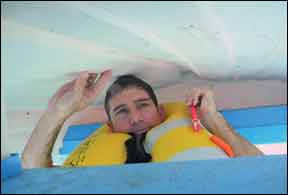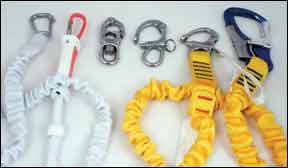After a series of tragic accidents involving sailors in organized sailing events and training programs in 2011 and 2012, Practical Sailor initiated research into safety equipment in use during the time of these accidents. Our current ongoing tests deal specifically with personal flotation devices (PFDs), safety harnesses, and combination inflatable PFDs and safety harnesses. Ultimately, we hope to come up with recommendations similar to those we made for infant PFDs in June 2007, when we published a prototype of what our ideal infant PFD would look like.

Ralph Naranjo
In response to our request for improvements to existing PFD and harness designs, dozens of readers have sent us their own ideas. One of the most common suggestions was a better dump valve similar to those that divers use to quickly release air from their buoyancy compensators. Many suggested that this feature would make it easier for a sailor to deflate an auto-inflating PFD if he were trapped under a boat.
Concern over sailors being trapped under a capsized boat isn’t new, but the topic has recently gained renewed attention-particularly in the small-boat arena. The 2012 US Sailing report about an Annapolis, Md., teenager drowning when the 420 she was sailing inverted, was soon followed by the deaths of two crew in the Chicago-Mackinac Race.
Survivors of the Chicago accident described how the auto-inflated PFD bladders and attached tethers impeded their escape. Advice from the crew of the 100-foot race boat Rambler, after it shed its keel and turned turtle in the 2011 Fastnet Race, carried more dire warnings about how an auto-inflating PFD can hamper ones ability to get clear of an overturned hull. (See “PS Tests Firstwatch Float Coats“.)
In our first round of research into just what happens when such situations arise, Practical Sailor Editor Darrell Nicholson and Technical Editor Ralph Naranjo tested the role of buoyancy during a capsize situation. They greatly simplified the challenge by using an inverted dinghy in a swimming pool as their test boat. The tested life jackets ranged from a basic vest-style Type III life jacket from Mustang Survival to top-of-the-line inflatable PFD/harnesses from Revere Supply Co. and West Marine. While it was a foregone conclusion that the PFDs would impede testers ability to escape, what they did not expect was the degree to which some of the PFDs seriously interfered with ones ability to simply get oriented under the boat. Add a wide deck, running rigging, lifelines, and even a mild swell into the equation, and it became quite obvious how a life jacket can turn into a trap.

In other sports, participants recognize how essential gear can become a hazard, and they are trained how to respond in that event. Scuba diving courses teach beginners how to don and doff their tanks and buoyancy compensators. Sailors need the same kind of awareness and need to recognize the importance of being able to quickly release a tether or PFD. Some years ago, Type III life jackets had a drawstring that could be knotted, making quick release all but impossible. Today, there are harness-tethers attached to inflatable PFDs that lack a quick-release clip. They must be cut to affect an escape. In our opinion, this is as much of a potential hazard, and all PFDs should be easy to release.
One of the most important observations made during this initial round of testing was how important it is to practice bleeding air from the PFD bladders. All it takes is a pinky finger press on the Schrader-like valve in the oral inflation tube, but without practice and during an emergency, the task can be tricky-particularly if you are wearing gloves or have large fingers. Re-inflation using the same tube was easier, but is also worth practicing.
In the second phase of this test, well be looking at specific gear and evaluating factors such as the ease with which each can be put on and removed. Well evaluate the likelihood of tethers and thigh straps tangling with rigging and hardware and how the equipment behaves when a crew attempts to scurry back on board, swim to a life raft, or reach a flotation device. We will also be looking at several different types of quick-release shackles for use in tethers-including some shackles currently being used by the U.S. military and action sports like kite boarding. We continue to invite reader input on this topic.



































